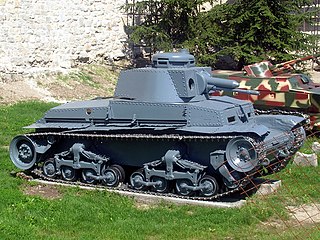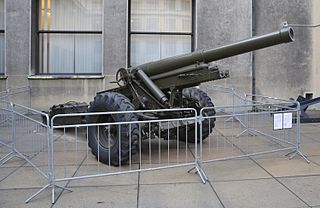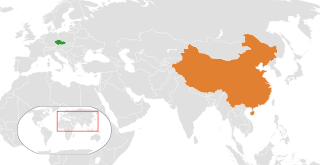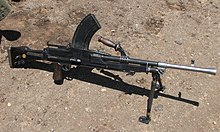
The Czech Armed Forces, also known as the Czech Army, is the military service responsible for the defence of the Czech Republic as part of the Armed Forces of the Czech Republic alongside the Military Office of the President of the Republic and the Castle Guard. The army consists of the General Staff, the Land Forces, the Air Force and support units.

The Bren gun was a series of light machine guns (LMG) made by Britain in the 1930s and used in various roles until 1992. While best known for its role as the British and Commonwealth forces' primary infantry LMG in World War II, it was also used in the Korean War and saw service throughout the latter half of the 20th century, including the 1982 Falklands War. Although fitted with a bipod, it could also be mounted on a tripod or be vehicle-mounted.

The Panzerkampfwagen 38(t), originally known as the ČKD LT vz. 38, was a tank designed during the 1930s, which saw extensive service during World War II. Developed in Czechoslovakia by ČKD, the type was adopted by Nazi Germany following the annexation of Czechoslovakia. With the German Army and other Axis forces, the type saw service in the invasions of Poland, France and the USSR. Production ended in 1942, when its main armament was deemed inadequate. In all, over 1,400 Pz. 38(t)s were manufactured. The chassis of the Pz. 38(t) continued to be produced for the Marder III (1942–1944) with some of its components used in the later Jagdpanzer 38 (1944–1945) tank destroyer and its derivative vehicles.

The Panzerkampfwagen 35(t), commonly shortened to Panzer 35(t) or abbreviated as Pz.Kpfw. 35(t), was a Czechoslovak-designed light tank used mainly by Nazi Germany during World War II. The letter (t) stood for tschechisch (German for "Czech"). In Czechoslovak service, it had the formal designation Lehký tank vzor 35 (Light Tank Model 35), but was commonly referred to as the LT vz. 35 or LT-35.

The military occupation of Czechoslovakia by Nazi Germany began with the German annexation of the Sudetenland in 1938, continued with the creation of the Protectorate of Bohemia and Moravia, and by the end of 1944 extended to all parts of Czechoslovakia.

The Škoda Works was one of the largest European industrial conglomerates of the 20th century, founded by Czech engineer Emil Škoda in 1859 in Plzeň, then in the Kingdom of Bohemia, Austrian Empire. It is the predecessor of today's Škoda Auto, Doosan Škoda Power and Škoda Transportation companies.

The Škoda 149 mm K series was a line of heavy howitzer designs used by Germany, Turkey, Romania, Slovakia, and Yugoslavia during World War II.

The 3,7 cm KPÚV vz. 37 was an anti-tank gun produced by the Škoda Works that saw service in World War II. Originally designed for the Czechoslovak Army, some were also sold to Yugoslavia. A number were appropriated by the Germans after the German occupation of Czechoslovakia in 1939 and used under the designations 3,7 cm PaK 37 (t). Captured Yugoslav guns were used under the designation of 3,7 cm Pak 156 (j). Slovakia acquired 158 when it declared independence from Czechoslovakia in March 1939.
The vz. 24 rifle is a bolt-action carbine designed and produced in Czechoslovakia from 1924 to 1942. It was developed from the German Mauser Gewehr 98 line, and features a similar bolt design. The rifle was designed in Czechoslovakia shortly after World War I, to replace the Vz. 98/22, also a Czech derivative of the Gewehr 98. The vz. 24 featured a 590 mm (23.2 in) barrel which was shorter and considered more manageable than the 740 mm (29.1 in) Gewehr 98 barrel. The vz. 24 was chambered in 7.92×57mm Mauser like its predecessors.

Tanks were initially deployed in World War I, engineered to overcome the deadlock of trench warfare. Between the two world wars, tanks were further developed. Although they had demonstrated their battlefield effectiveness, only a few nations had the industrial resources to design and build them. During and after World War I, Britain and France pioneered tank technology, with their models generally serving as a blueprint for other countries. However, this initial advantage would slowly diminish during the 1930s, shifting in favor of the Soviet Union and, to a lesser degree, Nazi Germany.

The ZB vz. 26 was a Czechoslovak light machine gun developed in the 1920s, which went on to enter service with several countries. It saw its major use during World War II, and spawned the related ZB vz. 27, vz. 30, and vz. 33. The ZB vz. 26 influenced many other light machine gun designs including the British Bren light machine gun and the Japanese Type 97 heavy tank machine gun. The ZB-26 is famous for its reliability, simple components, quick-change barrel and ease of manufacturing. This light machine gun in the Czechoslovak army was marked as the LK vz. 26. ZB vz. 26 is incorrect nomenclature because "ZB-26" is a factory designation, while "vzor 26" or "vz. 26" is an army designation.

The 76 mm mountain gun M1938 was a Soviet gun used in World War II.

The ZB-30 and ZB-30J were Czechoslovakian light machine guns that saw extensive use during World War II.
Between June 1947 and October 31, 1949, the Jewish agency seeking weapons for Operation Balak, made several purchases of weapons in Czechoslovakia, some of them of former German army weapons, captured by the Czechoslovak army on its national territory, or newly produced German weapons from Czechoslovakia's post-war production. In this deal, sale activities of Czechoslovak arms factories were coordinated by a special-purpose department of the Československé závody strojírenské a kovodělné, n.p. Holding, called Sekretariát D, headed by Gen. Jan Heřman (ret.).

On 20–21 August 1968, the Czechoslovak Socialist Republic was jointly invaded by four Warsaw Pact countries: the Soviet Union, the Polish People's Republic, the People's Republic of Bulgaria and the Hungarian People's Republic. The invasion stopped Alexander Dubček's Prague Spring liberalisation reforms and strengthened the authoritarian wing of the Communist Party of Czechoslovakia (KSČ).

Zdeněk Fierlinger was a Czechoslovak diplomat and politician. He served as the prime minister of Czechoslovakia from 1944 to 1946, first in the London-based Czechoslovak government-in-exile and then in liberated Czechoslovakia. Long close to the Soviet Union, he has his name often associated with the merger of his Czech Social Democratic Party with the Czechoslovak Communist Party after the communist coup in 1948.

China–Czech Republic relations or Sino–Czech relations are international relations between China and the Czech Republic. There were official relations by 1919 and formally established relations followed on 6 October 1949 between Czechoslovakia and China. In 1993, the Czech Republic was established and inherited the Czechoslovak treaty. The relations, trade and tourism between the China and the Czech Republic improved rapidly since the 1990s; and in the 2010s, agreements were made for more thorough economic improvements. Recently, relations have deteriorated due to major Czech politicians visiting Taiwan.

This article deals with the history of tanks employed by military forces in Czechoslovakia from the interwar period, and the more conventional tanks designed for the Czechoslovak Army before World War II, and the tanks that ended up as Panzers of the German Wehrmacht during World War II, or in the use of other countries who purchased them before the war began.

Relations between Czechoslovakia and the United States refer to two periods in Czechoslovakia's history. The first being the establishment of Czechoslovakia after its declaration of independence in 1918 from Austria-Hungary initiated by President Woodrow Wilson as part of his Fourteen Points following World War I. The second period being the communist era from 1948 when relations were strained, until 1992 when Czechoslovakia split forming the independent nations of the Czech Republic and Slovakia as a result of the 1989 Velvet Revolution.


















